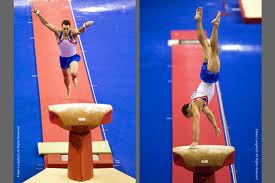Speed Training for Gymnasts
 How to get to the Vault or Double Mini Trampoline quicker
How to get to the Vault or Double Mini Trampoline quicker
Speed training for gymnasts is necessary in order to generate a faster approach to the Vault or Double Mini Trampoline (DMT). The sprint involves running for about 20-30m and then jumping onto a springboard or the DMT.
Speed training for gymnasts starts with posture (again)..
Strong hips help speed
Regular readers and athletes I work with will know that I start off with posture. It is hard to run fast if you are sagging like a jellyfish before you start.
Whilst gymnasts are very strong at what they do, their lifestyle is affecting their standing and running posture.
We have to put certain exercises and training in first to allow their bodies to get strong and support the speed. This is developing their structural integrity.
Coach the cause rather than the symptom
I made a mistake when first working with the Wellington Whirlwinds on trying to fix the very strange arm actions that the trampolinists had when running. I worked hard at getting them to use an “elbow high and back” arm action to be more efficient.
However, Gary Winckler had previously spoken to me about the upper body being an indicator of what was going on below. When I saw Gary at GAIN a few years ago, I said I had some success and he said the weird arm action was due to gymnasts being excessive plantor flexors which leads to straight leg running action, which then leads to straight arms.
DOH! Blindingly obvious when I thought about it. I had been working on the overall sprint mechanics but had been distracted by the arms.
We did a specific speed session out on the track with the group which was a breakthrough moment. We established some common drills and common language which made it easier to go back into the gym and coach on the runway.
This included:
- start positions
- foot mechanics
- co-ordination drills
to help the run action. Speed for gymnasts needs to be constantly refined and the warm-ups are a good place to reinforce these correct mechanics at every opportunity.
The exercise in this video is one that helps beginner sprinters get used to pushing off both legs from a standing start.
Shorten the run-up

Shorten the run-up
When working with the youngsters at Gemini, I asked them why they started their run-up where they did: they were just guessing.
When I watched them approach the vault, there was a lot of pitter-pattering as they got near and they were slowing down. This meant a loss of speed.
I got them to start near the springboard, then go back two metres at a time to see how they could maintain their speed. When they started the pitter-patter, they went forward again two metres. That was their new start position.
I got the youngsters to self- assess where they should start, rather than Carolyn and I dictate. This became an “honesty competition” and we were delighted that they became very accurate on their self-assessment.
There is little point starting a run-up from 30 metres away, then having to slow down as you approach take off. Instead, start short, get used to the takeoff and gradually increase the distance as you run faster and you can control that speed. Speed for gymnasts is different from top speed running because of the short distance.
When I coached at Exe Valley Gymnastics I helped this young gymnast who is very fast. She has a short run up (due to hall constraints) but really attacks the vault
Her foot strike is excellent, as is her hip position of the stance leg. However, she does use her arms too early, looking more like a long jumper here.
Here is me doing a less technically good and slower vault, but using the arms correctly:
Summary
Speed training for gymnasts is a work in progress because as the gymnasts develop their technical skills and perform more complex routines, they need more approach speed.
As they develop more approach speed, they need to be able to convert that speed into vertical/ horizontal jumping ability.
Underpinning all of this is strength/ posture to allow them to move efficiently and be robust enough to withstand the rigours of training.
Thanks to Carolyn and Bernie and everyone at the clubs for their input and efforts.
I am currently implementing these ideas in Willand and Wellington with the young gymnasts I work with at our gymnastics club. If anyone is interested in individual coaching on speed, then please contact me using the details at the top of the site.

This makes great reading James and thank you for the workshop – it was very interesting and I watch all of the gymnasts in training now. They even remember their starting lines
Interesting to read. Do you reckon the same rationale can be applied to a bowlers run up?
Running is running, the application becomes sport specific. The bowlers I have worked with have had trouble gaining correct run mechanics due to poor structural integrity. I start there, then work up.
[…] forward to next time. I have since worked with 2 clubs on their specifc speed training for gymnasts on the vault and double mini […]
[…] How to get gymnasts stronger, a reflective piece on how strength training has been applied. Speed training for gymnasts: a look at common running errors for the vault and DMT and how to get your gymnasts running […]
[…] Trampolining: Wellington Whirlwinds “Speed training for gymnasts“ […]